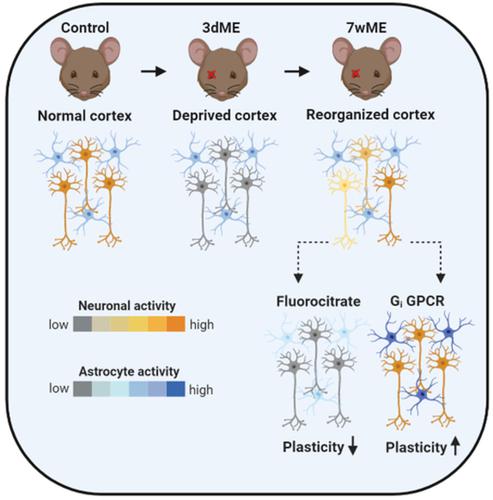Our official English website, www.x-mol.net, welcomes your
feedback! (Note: you will need to create a separate account there.)
Astrocytes shape the plastic response of adult cortical neurons to vision loss.
Glia ( IF 5.4 ) Pub Date : 2020-04-01 , DOI: 10.1002/glia.23830 Maroussia Hennes 1, 2, 3 , Nathalie Lombaert 1 , Jérôme Wahis 2, 3, 4 , Chris Van den Haute 5, 6 , Matthew G Holt 2, 3, 4 , Lutgarde Arckens 1, 3
Glia ( IF 5.4 ) Pub Date : 2020-04-01 , DOI: 10.1002/glia.23830 Maroussia Hennes 1, 2, 3 , Nathalie Lombaert 1 , Jérôme Wahis 2, 3, 4 , Chris Van den Haute 5, 6 , Matthew G Holt 2, 3, 4 , Lutgarde Arckens 1, 3
Affiliation

|
Astrocytes are vital for preserving correct brain functioning by continuously sustaining neuronal activity and survival. They are in contact with multiple synapses at once allowing the expansion of local synaptic events into activity changes in neuronal networks. Furthermore, cortical astrocytes integrate local sensory inputs and behavioral state. From an anatomical, molecular, and functional perspective, astrocytes are thus ideal candidates to influence complex large‐scale brain mechanisms such as plasticity. We collected evidence for the astrocytic potential for plasticity modulation, using the monocular enucleation (ME) mouse model of visual cortex plasticity. The impact of one‐eyed vision involves the functional recruitment of the deprived visual cortex by the spared senses within a 7‐week time frame, reflecting a substantial change in sensory information processing. In visually deprived cortex, a swift upregulation in Aldh1l1‐positive astrocyte density lasts until maximal functional recovery is reached. Transient metabolic silencing of visual cortex astrocytes at the time of ME induction, through intracranial fluorocitrate injections, reveals that astrocytes are required on site to achieve adequate long‐term neuronal reactivation. In addition, chronic stimulation by Gi but not Gq G‐protein coupled receptor activation of local astrocytes boosts the cortical plasticity phenomenon. Hence, functional manipulation of protoplasmic astrocytes has long‐lasting effects on the functional recovery of cortical neurons upon sensory loss, possibly by influencing the neuronal threshold to reactivate. Together, our results highlight an integral role for astrocytes in mediating adult cortical plasticity and unmask astrocyte specific Gi signaling as an interesting therapeutic pathway for brain plasticity regulation.
中文翻译:

星形胶质细胞塑造成人皮层神经元对视力丧失的塑性反应。
星形胶质细胞对于通过持续维持神经元活动和存活来保持正确的大脑功能至关重要。它们同时与多个突触接触,允许将局部突触事件扩展为神经元网络的活动变化。此外,皮质星形胶质细胞整合了局部感觉输入和行为状态。因此,从解剖学、分子和功能的角度来看,星形胶质细胞是影响复杂的大规模大脑机制(如可塑性)的理想候选者。我们使用视觉皮层可塑性的单眼摘除 (ME) 小鼠模型收集了星形胶质细胞可塑性调节潜力的证据。单眼视觉的影响涉及在 7 周的时间范围内,剩余的感官对被剥夺的视觉皮层的功能性募集,反映了感官信息处理的实质性变化。在视觉剥夺的皮层中,Aldh1l1 阳性星形胶质细胞密度的快速上调持续到达到最大功能恢复。通过颅内注射氟柠檬酸盐,ME 诱导时视觉皮层星形胶质细胞的瞬时代谢沉默表明,星形胶质细胞需要在现场实现足够的长期神经元再激活。此外,G 的慢性刺激 表明现场需要星形胶质细胞才能实现足够的长期神经元再激活。此外,G 的慢性刺激 表明现场需要星形胶质细胞才能实现足够的长期神经元再激活。此外,G 的慢性刺激i但不是 G q G 蛋白偶联受体激活局部星形胶质细胞可增强皮质可塑性现象。因此,原生质星形胶质细胞的功能操作对感觉丧失后皮层神经元的功能恢复具有长期影响,可能是通过影响重新激活的神经元阈值。总之,我们的结果突出了星形胶质细胞在介导成人皮质可塑性和揭示星形胶质细胞特异性 G i信号作为大脑可塑性调节的有趣治疗途径中不可或缺的作用。
更新日期:2020-04-01
中文翻译:

星形胶质细胞塑造成人皮层神经元对视力丧失的塑性反应。
星形胶质细胞对于通过持续维持神经元活动和存活来保持正确的大脑功能至关重要。它们同时与多个突触接触,允许将局部突触事件扩展为神经元网络的活动变化。此外,皮质星形胶质细胞整合了局部感觉输入和行为状态。因此,从解剖学、分子和功能的角度来看,星形胶质细胞是影响复杂的大规模大脑机制(如可塑性)的理想候选者。我们使用视觉皮层可塑性的单眼摘除 (ME) 小鼠模型收集了星形胶质细胞可塑性调节潜力的证据。单眼视觉的影响涉及在 7 周的时间范围内,剩余的感官对被剥夺的视觉皮层的功能性募集,反映了感官信息处理的实质性变化。在视觉剥夺的皮层中,Aldh1l1 阳性星形胶质细胞密度的快速上调持续到达到最大功能恢复。通过颅内注射氟柠檬酸盐,ME 诱导时视觉皮层星形胶质细胞的瞬时代谢沉默表明,星形胶质细胞需要在现场实现足够的长期神经元再激活。此外,G 的慢性刺激 表明现场需要星形胶质细胞才能实现足够的长期神经元再激活。此外,G 的慢性刺激 表明现场需要星形胶质细胞才能实现足够的长期神经元再激活。此外,G 的慢性刺激i但不是 G q G 蛋白偶联受体激活局部星形胶质细胞可增强皮质可塑性现象。因此,原生质星形胶质细胞的功能操作对感觉丧失后皮层神经元的功能恢复具有长期影响,可能是通过影响重新激活的神经元阈值。总之,我们的结果突出了星形胶质细胞在介导成人皮质可塑性和揭示星形胶质细胞特异性 G i信号作为大脑可塑性调节的有趣治疗途径中不可或缺的作用。











































 京公网安备 11010802027423号
京公网安备 11010802027423号